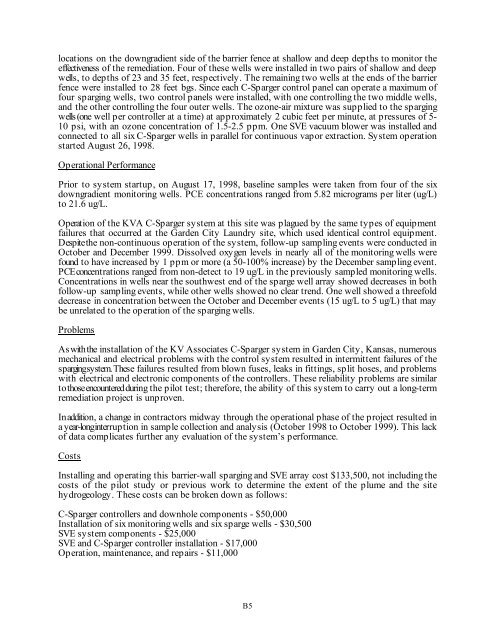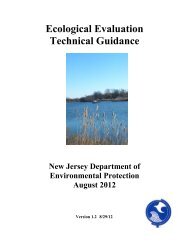Technical and Regulatory Guidance for In Situ Chemical ... - ITRC
Technical and Regulatory Guidance for In Situ Chemical ... - ITRC
Technical and Regulatory Guidance for In Situ Chemical ... - ITRC
Create successful ePaper yourself
Turn your PDF publications into a flip-book with our unique Google optimized e-Paper software.
locations on the downgradient side of the barrier fence at shallow <strong>and</strong> deep depths to monitor the<br />
effectiveness of the remediation. Four of these wells were installed in two pairs of shallow <strong>and</strong> deep<br />
wells, to depths of 23 <strong>and</strong> 35 feet, respectively. The remaining two wells at the ends of the barrier<br />
fence were installed to 28 feet bgs. Since each C-Sparger control panel can operate a maximum of<br />
four sparging wells, two control panels were installed, with one controlling the two middle wells,<br />
<strong>and</strong> the other controlling the four outer wells. The ozone-air mixture was supplied to the sparging<br />
wells (one well per controller at a time) at approximately 2 cubic feet per minute, at pressures of 5-<br />
10 psi, with an ozone concentration of 1.5-2.5 ppm. One SVE vacuum blower was installed <strong>and</strong><br />
connected to all six C-Sparger wells in parallel <strong>for</strong> continuous vapor extraction. System operation<br />
started August 26, 1998.<br />
Operational Per<strong>for</strong>mance<br />
Prior to system startup, on August 17, 1998, baseline samples were taken from four of the six<br />
downgradient monitoring wells. PCE concentrations ranged from 5.82 micrograms per liter (ug/L)<br />
to 21.6 ug/L.<br />
Operation of the KVA C-Sparger system at this site was plagued by the same types of equipment<br />
failures that occurred at the Garden City Laundry site, which used identical control equipment.<br />
Despite the non-continuous operation of the system, follow-up sampling events were conducted in<br />
October <strong>and</strong> December 1999. Dissolved oxygen levels in nearly all of the monitoring wells were<br />
found to have increased by 1 ppm or more (a 50-100% increase) by the December sampling event.<br />
PCE concentrations ranged from non-detect to 19 ug/L in the previously sampled monitoring wells.<br />
Concentrations in wells near the southwest end of the sparge well array showed decreases in both<br />
follow-up sampling events, while other wells showed no clear trend. One well showed a threefold<br />
decrease in concentration between the October <strong>and</strong> December events (15 ug/L to 5 ug/L) that may<br />
be unrelated to the operation of the sparging wells.<br />
Problems<br />
As with the installation of the KV Associates C-Sparger system in Garden City, Kansas, numerous<br />
mechanical <strong>and</strong> electrical problems with the control system resulted in intermittent failures of the<br />
sparging system. These failures resulted from blown fuses, leaks in fittings, split hoses, <strong>and</strong> problems<br />
with electrical <strong>and</strong> electronic components of the controllers. These reliability problems are similar<br />
to those encountered during the pilot test; there<strong>for</strong>e, the ability of this system to carry out a long-term<br />
remediation project is unproven.<br />
<strong>In</strong> addition, a change in contractors midway through the operational phase of the project resulted in<br />
a year-long interruption in sample collection <strong>and</strong> analysis (October 1998 to October 1999). This lack<br />
of data complicates further any evaluation of the system’s per<strong>for</strong>mance.<br />
Costs<br />
<strong>In</strong>stalling <strong>and</strong> operating this barrier-wall sparging <strong>and</strong> SVE array cost $133,500, not including the<br />
costs of the pilot study or previous work to determine the extent of the plume <strong>and</strong> the site<br />
hydrogeology. These costs can be broken down as follows:<br />
C-Sparger controllers <strong>and</strong> downhole components - $50,000<br />
<strong>In</strong>stallation of six monitoring wells <strong>and</strong> six sparge wells - $30,500<br />
SVE system components - $25,000<br />
SVE <strong>and</strong> C-Sparger controller installation - $17,000<br />
Operation, maintenance, <strong>and</strong> repairs - $11,000<br />
B5
















